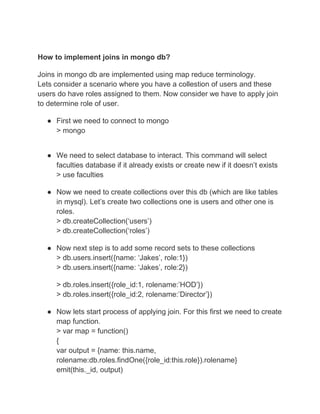How to implement joins in mongo db
•Als DOCX, PDF herunterladen•
1 gefällt mir•1,384 views
Mongo db is document based nosql database. Mongodb insert, reads are faster than mysql but joins are bit slower. Joins in mongo db are implemented using map reduce terminology.
Melden
Teilen
Melden
Teilen

Empfohlen
Weitere ähnliche Inhalte
Ähnlich wie How to implement joins in mongo db
Ähnlich wie How to implement joins in mongo db (20)
MongoDB installation,CRUD operation & JavaScript shell

MongoDB installation,CRUD operation & JavaScript shell
need help completing week 6 ilab.. i will upload what I currently ha.docx

need help completing week 6 ilab.. i will upload what I currently ha.docx
Accessing data through hibernate: what DBAs should tell to developers and vic...

Accessing data through hibernate: what DBAs should tell to developers and vic...
Accessing Data Through Hibernate; What DBAs Should Tell Developers and Vice V...

Accessing Data Through Hibernate; What DBAs Should Tell Developers and Vice V...
How to implement joins in mongo db
- 1. How to implement joins in mongo db? Joins in mongo db are implemented using map reduce terminology. Lets consider a scenario where you have a collestion of users and these users do have roles assigned to them. Now consider we have to apply join to determine role of user. ● First we need to connect to mongo > mongo ● We need to select database to interact. This command will select faculties database if it already exists or create new if it doesn’t exists > use faculties ● Now we need to create collections over this db (which are like tables in mysql). Let’s create two collections one is users and other one is roles. > db.createCollection(‘users’) > db.createCollection(‘roles’) ● Now next step is to add some record sets to these collections > db.users.insert({name: ‘Jakes’, role:1}) > db.users.insert({name: ‘Jakes’, role:2}) > db.roles.insert({role_id:1, rolename:’HOD’}) > db.roles.insert({role_id:2, rolename:’Director’}) ● Now lets start process of applying join. For this first we need to create map function. > var map = function() { var output = {name: this.name, rolename:db.roles.findOne({role_id:this.role}).rolename} emit(this._id, output)
- 2. }; ● Now time to create map function > var reduce = { function(key, values) { var outs = {name:null, rolename:null} values.forEach(function(v) { if(outs.name == null) { outs.name = v.name } if(outs.rolename == null) {outs.rolename = v.rolename } }); return outs; }; ● Now time to apply map reduce over the collection to be joined. > db.users.mapReduce(map,reduce,{out:’result_coll’}) ● Now result of join will be stored in result_coll, to check the output you can query result_coll. > db.result_coll.find() [Thanks for reading] ---------------------------------------------------------------------------------------------------------------------- Author: Prasoon Sharma Email: Prasoon.sharma1983@gmail.com
